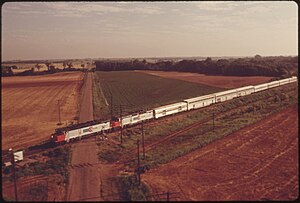
The Southwest Chief is a long-distance passenger train operated by Amtrak on a 2,265-mile (3,645 km) route between Chicago and Los Angeles through the Midwest and Southwest via Kansas City, Albuquerque, and Flagstaff. Amtrak bills the route as one of its most scenic, with views of the Painted Desert and the Red Cliffs of Sedona, as well as the plains of Illinois, Missouri, Kansas, and Colorado.
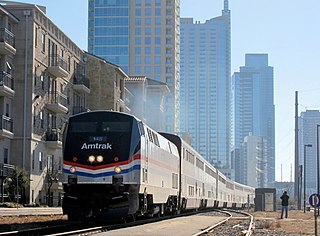
The Texas Eagle is a long-distance passenger train operated daily by Amtrak on a 1,306-mile (2,102 km) route between Chicago, Illinois, and San Antonio, Texas, with major stops in St. Louis, Little Rock, Dallas, Fort Worth, and Austin. Three days per week, the train joins the Sunset Limited in San Antonio and continues to Los Angeles via El Paso and Tucson. The combined 2,728-mile (4,390 km) route is the longest in the United States and the second-longest in the Americas, after the Canadian.

Dallas Union Station, officially Eddie Bernice Johnson Union Station, also known as Dallas Union Terminal, is a large intermodal railroad station in Dallas, Texas. It is the third busiest Amtrak station in Texas, behind Fort Worth Central Station and San Antonio station. It serves DART Light Rail Blue and Red lines, Trinity Railway Express commuter rail and Amtrak intercity rail. It is located on Houston Street, between Wood and Young Streets, in the Reunion district of Downtown Dallas. The structure is a Dallas Landmark and is listed on the National Register of Historic Places.

The Atchison, Topeka and Santa Fe Railway, often referred to as the Santa Fe or AT&SF, was one of the largest Class 1 railroads in the United States.

The Heartland Flyer is a daily passenger train that follows a 206-mile (332 km) route between Oklahoma City, Oklahoma, and Fort Worth, Texas. It is operated by Amtrak and jointly funded by the states of Oklahoma and Texas.
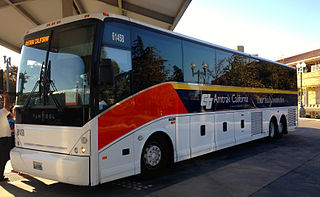
Amtrak Thruway is a system of through-ticketed transportation services to connect passengers with areas not served by Amtrak trains. In most cases these are dedicated motorcoach routes, but can also be non-dedicated intercity bus services, transit buses, vans, taxis, ferry boats and commuter rail trains.

The Desert Wind was an Amtrak long-distance passenger train that ran from 1979 to 1997. It operated from Chicago to Los Angeles as a section of the California Zephyr, serving Los Angeles via Salt Lake City; Ogden, Utah; and Las Vegas.
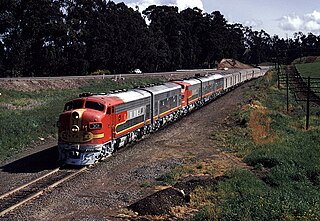
The San Francisco Chief was a streamlined passenger train on the Atchison, Topeka, and Santa Fe Railway between Chicago and the San Francisco Bay Area. It ran from 1954 until 1971. The San Francisco Chief was the last new streamliner introduced by the Santa Fe, its first full train between Chicago and the Bay, the only Chicago–Bay Area train running over just one railroad, and at 2,555 miles (4,112 km) the longest run in the country on one railroad. The San Francisco Chief was one of many trains discontinued when Amtrak began operations in 1971.

Santa Fe Depot, also known as the Santa Fe Transit Hub, is an Amtrak station located in downtown Oklahoma City, Oklahoma. It is the northern terminus of the Heartland Flyer, a daily train to Fort Worth, Texas.

Norman is an Amtrak station in Norman, Oklahoma. The station is serviced by the daily Heartland Flyer, which travels from Fort Worth, Texas to Oklahoma City, Oklahoma. The station building was added to the National Register of Historic Places in 1991 as the Santa Fe Depot.

Gainesville, officially the Gainesville Santa Fe Depot, is an Amtrak train station in Gainesville, Texas. The station is serviced by Amtrak's Heartland Flyer route, which travels from Fort Worth, Texas to Oklahoma City, Oklahoma.

Purcell is an Amtrak station in Purcell, Oklahoma. The station is serviced by Amtrak's daily Heartland Flyer, which travels from Oklahoma City, Oklahoma to Fort Worth, Texas.
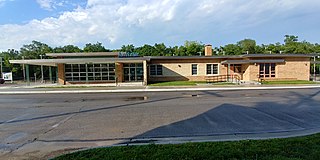
Lawrence station is a train station in Lawrence, Kansas, United States, served by Amtrak's Southwest Chief train. Built in 1956 to replace an older station, it was added to the National Register of Historic Places in 2018 as Santa Fe Depot.

The Texas Chief was a passenger train operated by the Atchison, Topeka and Santa Fe Railway between Chicago, Illinois, and Galveston, Texas. It was the first Santa Fe "Chief" outside the Chicago–Los Angeles routes. The Santa Fe conveyed the Texas Chief to Amtrak in 1971, which renamed it the Lone Star in 1974. The train was discontinued in 1979.

The Chicagoan and Kansas Cityan were a pair of American named passenger trains operated by the Atchison, Topeka and Santa Fe Railway. They ran between Chicago, Illinois and Oklahoma City, Oklahoma. The trains were introduced as a Chicago–Wichita service in 1938 and extended to Oklahoma City the next year. A Kansas City–Tulsa connecting train, the Tulsan, was also introduced at that time. The Chicagoan and Kansas Cityan ran until 1968, while the Tulsan ran until 1971.

The Prairie Marksman was a daily passenger train operated by Amtrak between Chicago's Union Station and East Peoria, Illinois. The route was an indirect successor to the Rock Island's Peoria Rocket.

Guthrie station is a former railway station in Guthrie, Oklahoma. Built in 1903, it saw passenger service until 1979 and is now a restaurant. The building is a contributing resource of the Guthrie Historic District.

The National Limited was a passenger train that ran between Kansas City, Missouri, and both New York City and Washington, D.C., splitting in Pennsylvania. Amtrak operated the train from 1971 to 1979.
The Eastern Flyer was a proposed medium distance inter-city train traveling between Oklahoma City in central Oklahoma and Tulsa in north-eastern Oklahoma. It was originally planned to be a private operation by the Iowa Pacific Railroad, and its services were to have included a dome car, coaches and full meal service. This would have been the first regular passenger service to Tulsa since the Santa Fe discontinued service in 1971.

Union Station is a former railway station in Wichita, Kansas. Since the end of passenger rail service to the city in 1979, it has been repurposed as commercial office space.
